The Drink of the Gods: An Introduction to Pulque
The history of pulque, a pre-Hispanic beverage made from the lightly fermented sap of the agave, is closely intertwined with the history of Mexico.
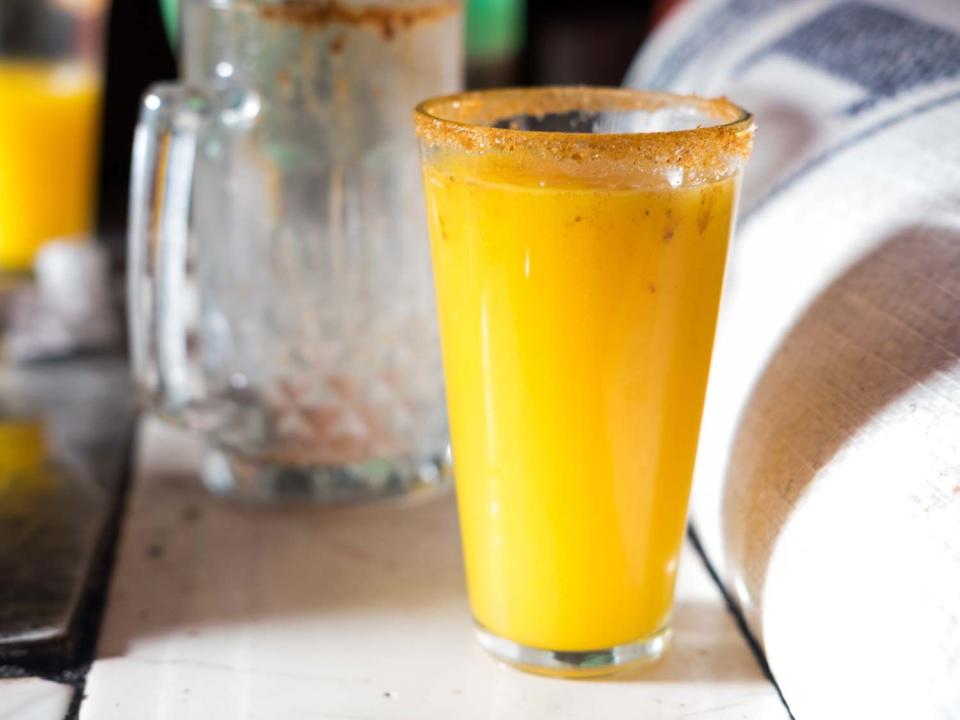
Serious Eats / Naomi Tomky
“What is more Mexican than pulque?”
Arturo Garrido Aldana asks me this question over the din of the crowd at Pulqueria las Duelistas, his century-old pulqueria located in Mexico’s Centro Histórico. Behind him, employees ladle out various flavors of the traditional drink into oversized Styrofoam and plastic cups, handing them over to waiting patrons. At the front of the mural-covered room, a swamp cooler emits its sustained drone, indiscernible beneath the music pounding from the speakers. Here, in the center of Mexico's capital, Garrido tells me pulque "is the heart of Mexico."
Pulque is a pre-Hispanic beverage with a consistency reminiscent of kombucha, if kombucha were made from okra. It’s about as alcoholic as beer, but it’s made from the lightly fermented sap of the agave—the same plant that’s used to make tequila and mezcal. The flavor, once you acquire a taste for it, is intriguingly zingy. Natural, or plain, pulque is an opaque milky color but fizzy and bright on the tongue. Sweet, but not cloying, lightly viscous but (assuming it’s fresh) not slimy, and just ever-so-subtly yeasty, like the whiff of freshly risen bread dough hitting the oven. Most places offer both plain or natural pulque and curado, or flavored, versions, which temper the drink’s tang but not its texture. And for those who enjoy it, pulque lives up to its reputation as the drink of the Gods: refreshing and eye-opening, satisfying and comforting. Even to those who find the flavor or texture gross, it offers a comforting fullness (or, perhaps, that's the light buzz talking?).
Quick to Ferment, Quick to Perish
To produce pulque, the heart of a mature agave (maguey) plant is cut out, creating a cavity. The cavity is scraped, which induces the flow of sap, called aguamiel, into the cavity, where it gets collected. While the process for making mezcal and tequila requires that aguamiel be cooked, pulque is made by naturally fermenting the raw product in a cask. The fermentation happens quickly, so quickly that the fermented liquid reaches its fizzy, low-alcohol final form in a matter of hours.
The rapid fermentation is responsible for two indelible characteristics of pulque: the best pulque is freshly made, and the drink doesn’t travel well, both of which make it endemic to central Mexico. As a result, its history is closely intertwined with the history of the country, from its pre-Hispanic origins to its current revival, and the various roles it has occupied are a reflection of that, too: It was believed to be the nectar of the gods; it became the preferred drink of emperors; more recently, it was considered the scourge of the unwashed masses, which led to its colonial-era ban; and now, finally, it has become a beverage enjoyed by old-timers and young hipsters alike. The story of pulque is rich, deep, and best taken in with a long, slow pulls from a cacariza, the pockmarked glass container that is as iconic in a pulqueria as a stein in a beer hall.
Pulque in Central Mexican History
Before the process of distillation arrived in North America, pulque ruled the region of central Mexico. A mural in Cholula called “Los Bebedores,” or “The Drinkers,” from 1000 CE offers the first confirmed evidence of pulque, but scientific research places its origin as far back as 200 CE. Pulque was thought to be a gift from the gods: Mayahuel, goddess of maguey, gave pulque to the Aztecs, and it was a sip of pulque given to Quetzalcoatl by his brother, the god Tezcatlipoca, that intoxicated him and led him to abandon his celibacy, which in turn made him decide to flee. (His return, according to the legend, was to happen in a year that coincided with the eventual arrival of Spanish colonizers.)
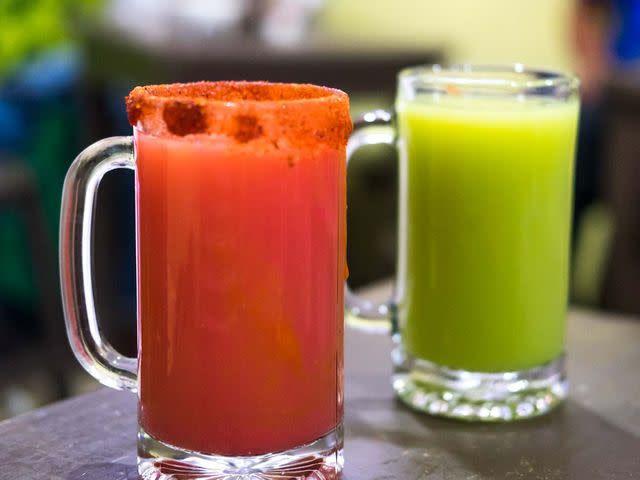
Serious Eats / Naomi Tomky
During the Aztec era, pulque was a sacred drink, a beverage reserved for the gods and their priests. When the Aztec empire fell, however, it became a drink of the people, produced widely around the central Mexican highlands, and a major economic driver in the area. During the colonial era, the Spanish Crown tried to outlaw pulque production, citing ties to non-Christian religions and claims that it caused major health and social issues among indigenous people. (Ironic, given that many indigenous peoples considered it curative.) But the economic power of maguey put an end to the prohibition in 1786: even during the ban, the Crown was collecting millions of pesos in taxes on pulque.
Through the Mexican War of Independence and the Mexican Revolution, pulque remained an important and valued beverage. But it was more than just a drink: it was medicine, culture, and a significant moneymaker. The introduction of railways sped the perishable drink from the producing haciendas in the hills into the valley of Mexico City and other cities, where there was growing demand. Toward the end of the 19th century, pulque was the main alcoholic drink and maguey production occupied an outsize role in Mexican agriculture. However, following the revolution, President Porfirio Díaz courted foreign investment—including from breweries, which ended up pitting pulque against beer for drinkers’ pesos.
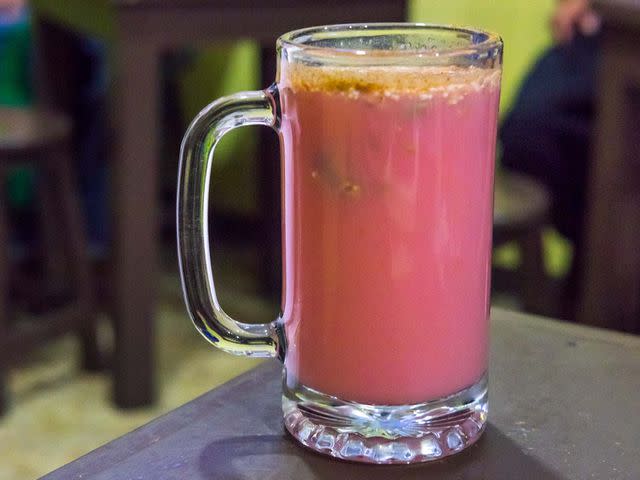
Serious Eats / Naomi Tomky
“Pulque,” says Mexico City–based food and travel writer Arturo Torres Landa, “like many things in Mexico, is a story of resistance.” When beer came to Mexico, an aggressive marketing campaign, assisted by government efforts to increase local demand for beer, sought to repeat the colonial-era framing of pulque as dirty and low-class, the stuff of a rural backwater. “It was seen as primitive and rustic,” Torres explains, which made it easier for rumors to be spread—generally assumed to originate from beer companies—that pulque was unhygienic and possibly fermented with feces. But the drink persisted, much as it had through the destruction of a great civilization and the crush of a colonial power.
Modern Pulqueria Culture
Today, like the dream of the 1890s, pulque's resurgence serves as an example of how everything old can be new again: at bars like Las Duelistas in Mexico City, three-day drunks bob their heads at the bar while young hipsters share pitchers. Garrido bought the 106-year-old bar 12 years ago out of his love for pulque. He’d been working in pulquerias since the ‘70s, and he heard business at Las Duelistas was bad and it would close. So he bought it. “How could I not?” he asked. The pulque-drinking crowd seems like a jumble of people of all ages, but Torres says there’s a generation missing—the one that lies between the young people and hipsters who have fueled the drink’s revival and the older folks “who grew up drinking it like it was water.”
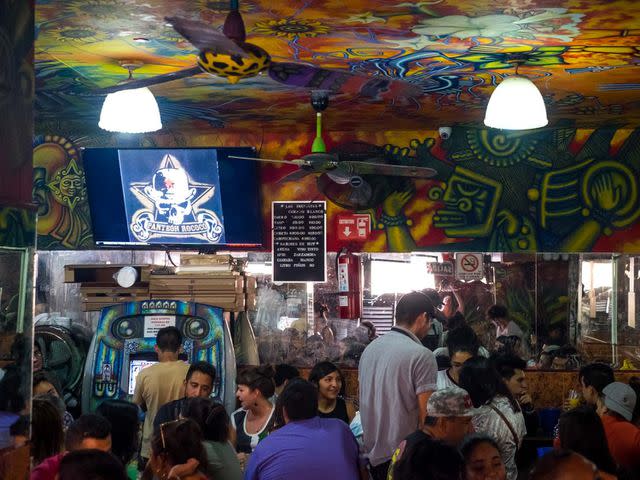
Serious Eats / Naomi Tomky
While you can find pulque in other places—floating vendors in the canals of Xochimilco, at street markets, and almost anywhere that sells the pit-cooked lamb called barbacoa—the best selection comes from pulquerias, and they are most certainly the environment that best demonstrates central Mexico's unique tradition of pulque. Because of the limited transportation and the limited area where the agave grows, the drink stays pretty local to Mexico City and surrounding Mexico State, and the nearby states of Tlaxcala, Puebla, and Hidalgo. The fresher the pulque, the better, cleaner, and more refreshing the flavor; the drink's texture is also smoother when fresh, as it tends to grow more viscous over time and can take on an off-putting stringiness. For those reasons, good pulque rarely makes it out of central Mexico, so drinking pulque in pulquerias in these parts not only gives you a taste of the drink at its best but also an experience of where it comes from.
Pulquerias tend to be barebones and lowbrow, the walls pasted with photos of scantily clad women, the floors interminably sticky, and they rarely offer anything to eat other than bowls of suspect snacks. And yet, many in Mexico City are decorated with murals, some depicting famous figures in history, others that honor pulque, its past, the way it’s made, or how good it is to drink. In La Cátedral del Pulque, which has ladled out the drink since 1947 in Mexico City’s Obrero neighborhood, Torres points out a mural featuring David Alfaro Siqueiros as protagonist, a muralist contemporary of Diego Rivera and José Clemente Orozco, and attempted assassin of Leon Trotsky. Another wall shows an adaptation of Michelangelo’s "Creation of Adam," in which God pours pulque from his jicara, a traditional drinking vessel made from a gourd, into one held out by Adam.
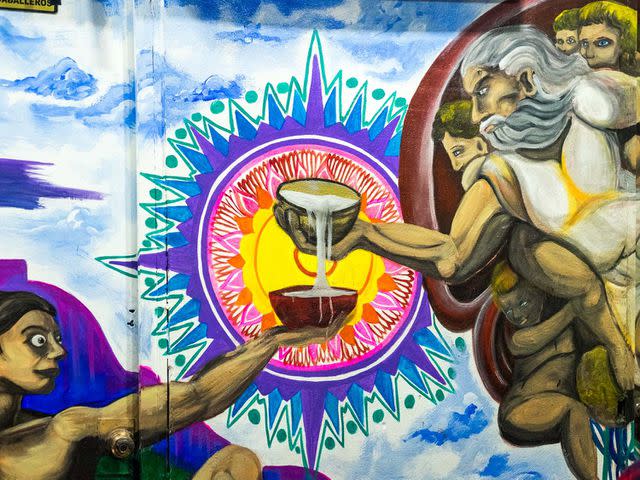
Serious Eats / Naomi Tomky
The history and culture, as well as the variety of drinks on offer, make it worth seeking a good pulqueria out. The bar at La Cátedral del Pulque hosts a series of open-topped glass jars, called vitroleros, each with a sign hanging around its neck to identify the flavor of the curados inside. On the day of my visit, La Cátedral offered curados of celery, cranberry, oatmeal, pine nut; “angel’s kiss” (cherry, oatmeal, amaranth); and a tomato with oyster one that evoked Clamato and was served with a spicy salted rim.
A short distance away, Las Duelistas offered, among others, a guava, blackberry, and red wine pulque vaguely reminiscent of sangria. Drinkers order them by the small glass or the giant carafe, some stopping by the bar for a single cup and others lingering over plastic pitcher after plastic pitcher. Curados make for easy drinking and are overwhelmingly more popular than plain pulque because of the way they ameliorate common complaints about the drink’s off-flavors or slimy texture, even if those complaints are only applicable to less-than-fresh pulque. Because it has to be fresh, the pulque at Las Duelistas comes in from Tlaxcala, about two hours east of Mexico City, every day at 3 a.m., at which point the bar mixes up a few of the 46 different flavors it offers on rotation. It seems hard to believe that this spot, recently so close to going out of business, now sells as much as 900 liters of pulque in a single day.
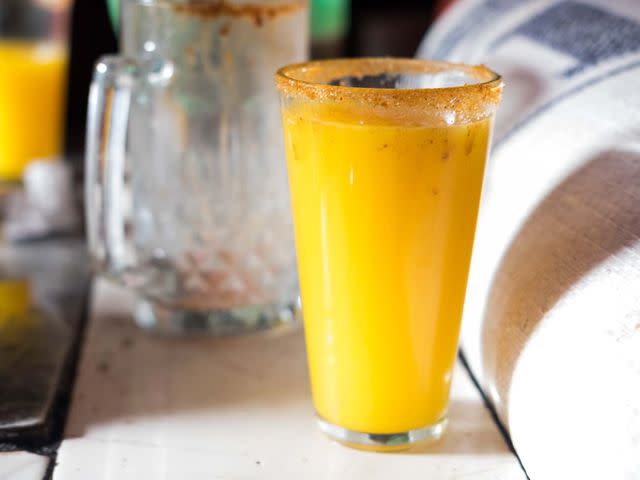
Serious Eats / Naomi Tomky
Drinking pulque is a way to reclaim a part of Mexican identity that always seems to be on the verge of being lost or forgotten. In describing his love for the drink and what it means to Mexicans and central Mexicans, Garrido seems to swell with pride at the quantity they sell, as if he, personally, in pouring out glasses of this drink, is handing the next generation a piece of their identity, one that's uniquely tied to a plant that grows only here, one that can’t travel far without suffering grievously in quality.
For the curious tourists, the hipster locals, the older men alone at the bar with an oversized, chipped stein, each glass of pulque is a little bit of Mexico. It helps visitors feel close to the location, helps the long-timers remember earlier days, and helps the youth feel connected to the past. The pulquerias all across Mexico City, both new and old, bring what was once the drink of gods and emperors, then of the rural poor, to the urban masses, one sip at a time.
February 2019
